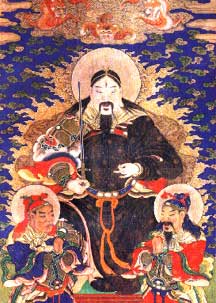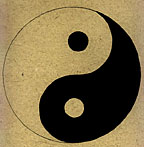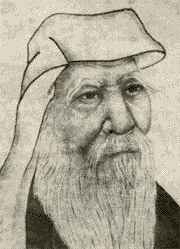Philosophy of Religion
Chapter 2. Religions of the World
Section 6 . Taoism .





· THE ABSOLUTE: what do the believers hold as most important? What is the ultimate source of value and significance? For many, but not all religions, this is given some form of agency and portrayed as a deity (deities). It might be a concept or ideal as well as a figure.
· THE WORLD: What does the belief system say about the world? Its origin? its relation to the Absolute? Its future?
· HUMANS: Where do they come from? How do they fit into the general scheme of things? What is their destiny or future?
· THE PROBLEM FOR HUMANS: What is the principle problem for humans that they must learn to deal with and solve?
· THE SOLUTION FOR HUMANS: How are humans to solve or overcome the fundamental problems ?
· COMMUNITY AND ETHICS: What is the moral code as promulgated by the religion? What is the idea of community and how humans are to live with one another?
· AN INTERPRETATION OF HISTORY: Does the religion offer an explanation for events occurring in time? Is there a single linear history with time coming to an end or does time recycle? Is there a plan working itself out in time and detectable in the events of history?
· RITUALS AND SYMBOLS: What are the major rituals, holy days, garments, ceremonies and symbols?
· LIFE AFTER DEATH: What is the explanation given for what occurs after death? Does he religion support a belief in souls or spirits which survive the death of the body? What is the belief in what occurs afterwards? Is there a resurrection of the body? Reincarnation? Dissolution? Extinction?
·
RELATIONSHIP TO OTHER
RELIGIONS: What is the prescribed manner in which believers are to regard
other religions and the followers of other religions?
**********************************************************
For those who wish to listen to information on the world's
religions here is a listing of PODCASTS on RELIGIONS by Cynthia
Eller.
************************************************************
If you have iTunes on your computer just click and you will be led to the
listings.
http://phobos.apple.com/WebObjects/MZStore.woa/wa/viewPodcast?id=117762189&s=143441
Here is a link to the site for the textbook REVEALING WORLD RELIGIONS
related to which these podcasts were made.
http://thinkingstrings.com/Product/WR/index.html
I. Introduction
Daoism, Chinese philosophical and religious system, dating from about the 4th century BC. Among native Chinese schools of thought, the influence of Daoism has been second only to that of Confucianism.
II. Basic Tenets
The essential Daoist philosophical and mystical beliefs can be found in the Daodejing (Tao-te Ching, Classic of the Way and Its Power) attributed to the historical figure Laozi (Lao-tzu, 570?-490? BC) and possibly compiled by followers as late as the 3rd century BC. Whereas Confucianism urged the individual to conform to the standards of an ideal social system, Daoism maintained that the individual should ignore the dictates of society and seek only to conform with the underlying pattern of the universe, the Dao (or Tao, meaning “way”), which can neither be described in words nor conceived in thought. To be in accord with Dao, one has to “do nothing” (wuwei)—that is, nothing strained, artificial, or unnatural. Through spontaneous compliance with the impulses of one's own essential nature and by emptying oneself of all doctrines and knowledge, one achieves unity with the Dao and derives from it a mystical power. This power enables one to transcend all mundane distinctions, even the distinction of life and death. At the sociopolitical level, the Daoists called for a return to primitive agrarian life.
III. History
Unsuited to the development of an explicit political theory, Daoism exerted its greatest influence on Chinese aesthetics, hygiene, and religion. Alongside the philosophical and mystical Daoism discussed above, Daoism also developed on a popular level as a cult in which immortality was sought through magic and the use of various elixirs. Experimentation in alchemy gave way to the development, between the 3rd and 6th centuries, of various hygiene cults that sought to prolong life. These developed into a general hygiene system, still practiced, that stresses regular breathing and concentration to prevent disease and promote longevity.
About the 2nd century AD, popular Daoist religious organizations concerned with faith healing began to appear. Subsequently, under the influence of Buddhism, Daoist religious groups adopted institutional monasticism and a concern for spiritual afterlife rather than bodily immortality. The basic organization of these groups was the local parish, which supported a Daoist priest with its contributions. Daoism was recognized as the official religion of China for several brief periods. Various Daoist sects eventually developed, and in 1019 the leader of one of these was given an extensive tract of land in Jiangxi (Kiangsi) Province. The successors of this patriarch maintained control over this tract and nominal supremacy over local Daoist clergy until 1927, when they were ousted by the Chinese Communists. In contemporary China, religious Daoism has tended to merge with popular Buddhism and other religions.
| Special thanks to the Microsoft Corporation for their contribution to our site. The information above came from Microsoft Encarta. Here is a hyperlink to the Microsoft Encarta home page. http://www.encarta.msn.com |
| Master | Meaning | Power | Quietude | Values | Conclusion | Tao Te Ching 1 | Tao Te Ching 2 |
Taoism: Introductions
|
Basics of Taoism http://www.edepot.com/taoism.html Basics of Taoism along with fundamental resources for
additional information. | Taoism | http://www.religioustolerance.org/taoism.htm [One-page simple summary from the Ontario Consultants on Religious Tolerance.] | Taoism,
or the Way | http://www.askasia.org/frclasrm/readings/r000005.htm [An academic introduction written by Judith A. Berling for Focus on Asian Studies, a publication of the Asia Society.] | | | | |
| About Alternative Religions (Taoism) http://www.religioustolerance.org/taoism.htm |
Taoism: History and Canon
|
The
Taoist Canon: A Guide to Studies and Reference Works http://venus.unive.it/dsao/pregadio/tools/daozang/dz_0.html Note: This server may be unavailable from time to time. If so, try again later. ~ [Fabrizio Pregadio's scholarly guide provides useful information about the canon, its categories, and individual texts. The version of the Guide that is linked requires no Chinese language skills. If you are skilled in reading characters and have your browser set to represent them properly via Big5, you can select an alternative version of the files once you have connected to Dr. Pregadio's Chinese and Asian Studies site.] |
Taoism: Images, Books, and Bibliographies
| Recommended
Reading http://www.clas.ufl.edu/users/gthursby/taoism/introbib.htm [A basic list of recent books in English. Recommended for beginners, students, and others who want more detailed information and more advanced interpretation of Taoism.] |
Background: Chinese History and Culture
| Calabash
Gate: In a Calabash, a Chinese Myth of Origins http://www.fengshuigate.com/calabash/index.html [An introduction and translation by Stephen L. Field of Trinity University. Requires patient attention.] | | | Classical
Historiography for Chinese History | http://www.sscnet.ucla.edu/history/elman/ClassBib/ [An extensive set of resources, some of them for advanced students, provided by Professor Benjamin A. Elman at the University of California at Los Angeles.] | Condensed China | http://asterius.com/china/ [Chinese History for Beginners, provided by Paul Frankenstein, is not a complete history of China, but is an very useful "greatest hits" or "Cliff's Notes" that is an excellent starting-point for the beginner or quick review for the old hand who happens to be forgetful. The information is divided into the following sections for easy access: Introduction, The Origins of Chinese Civilization, The Early Empire, The Second Empire, The Birth of Modern China, and Bibliography.] | Internet
East Asian History Sourcebook | http://www.fordham.edu/halsall/eastasia/eastasiasbook.html [A large set of linked resources on China, its cultures and religions, in the context of its geographical setting.] |
Taoist web sites:
| Jeff Rasmussen's Tao Te Ching web site features an illustrated Tao Te Ching, an introduction to Taoism, and links. See: http://www.symynet.com/tao_te_ching/ | |
| Bill Mason's Taoism Page is at: http://www.taoism.net This web site emphasizes the practical application of the Tao to everyday life. | |
| Maury Merkin, "Daoism in brief," is at: http://www.his.com/~merkin/ This website offers a brief introduction to Taoism and a glossary of terms. | |
| "The Taoist Canon: A guide to studies and reference works" at: http://helios.unive.it/~dsao/pregadio/tools/daozang/ | |
| The "Taoism Information Page" is at: http://www.clas.ufl.edu/users/gthursby/taoism | |
| The "Taoism Depot" contains a Taoism discussion forum, live chat and a wide range of resources. See: http://www.edepot.com/taoism.html | |
| Western Reform Taoism has an excellent web site which publishes their creed and beliefs on dozens of important topics. See: http://wrt.org/ | |
| The Taoist Restoration Society (TRS) is "a U.S. nonprofit corporation dedicated to the rehabilitation and rebirth of China's Taoist tradition." See: http://www.taorestore.org/intro.html | |
|
Taoism information page | |
|
Virtual Library Information Page
http://www.clas.ufl.edu/users/gthursby/taoism/ | |
|
University of Florida – Historical outlines and
summary http://www.clas.ufl.edu/users/gthursby/taoism/intros.htm | |
|
Information on Taoism supported by captioned texts
http://www.37.com/37w2.htm | |
|
Academic Resources
http://www.academicinfo.net/chinarelig.html#Taoism
| |
| The Center of traditional Taoist studies: a non-profit
religious organization established to encourage traditional Taoist
studies. The Center offers
four integrated programs to provide the introductory knowledge required to
be a student of Tao; Martial Arts & Chi Quong to train the body and
The Yin and Yang of Meditation and Philosophy to provide training for the
mind. | |
|
Emphasizing the application of the Tao to everyday life. |
| The Abode of the Eternal Tao | |
| Taoism Information Page | |
| EAWC Anthology: The Art of War |
SACRED TEXTS : http://www.sacred-texts.com/tao/index.htm
Proceed to the next section by clicking here> next
© Copyright Philip A. Pecorino 2001. All Rights reserved.
Web Surfer's Caveat: These are class notes, intended to comment on readings and amplify class discussion. They should be read as such. They are not intended for publication or general distribution.